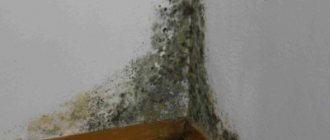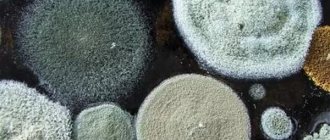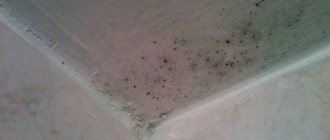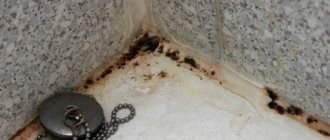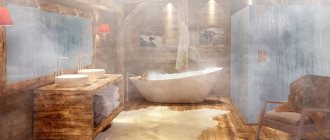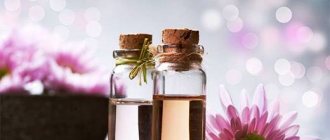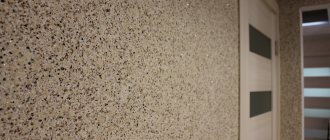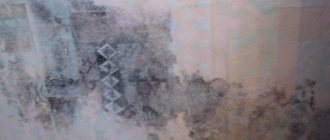After repairs, especially if they are done poorly, black mold may appear under the wallpaper. Everyone has heard about it, but hardly anyone really thought that they would be faced with such a situation. Everyone thinks that mold only occurs on spoiled food or in basements, but it can be much closer.
If you notice mold on the surface of the canvas, this means that it has already turned into a form hazardous to health. Simply cleaning it will not be enough, and you will have to remove all the finishing material.
Assessing the scale of infection
The first step is a thorough inspection of the apartment. It is necessary to understand the reasons and assess the scale of the infection. Fungal infections can occur on both a local and global scale.
If the fungus has affected a small area, a high-quality treatment of the affected areas may be sufficient. If mold has spread over a large area, local repairs will have to be carried out using chemicals. If more than 20% of the wallpaper is damaged, drastic measures cannot be avoided. You may need to contact a specialist.
It is very important to eliminate the causes of fungal development, otherwise all subsequent operations will give only temporary results.
Prevention of mold formation
Preventing the development of mold is easier than fighting it. To prevent fungus on wallpaper, you should follow a number of rules:
Ventilation of premises
- when carrying out the first repair, insulate the walls if necessary;
- during the next repair, before pasting, treat the working surface with preventive compounds;
- inspect corners, joints and slopes for the presence of mold and remove the fungus that has already appeared, leaving it no chance for further development under the wallpaper;
- do not allow excess humidity - if the room is flooded, promptly dry the walls and then spray them with special antifungal agents;
- ventilate the room and create drafts as often as possible;
- open the curtains over the entire window opening at least once a day, preferably for several hours - sunlight suppresses the fungus;
- do not move furniture too close to the walls - there should be a gap of 5 centimeters or more for air circulation;
- light scented candles from time to time - essential oils of lemon, orange, bergamot have fungicide properties.
The list is not exhaustive.
How to eliminate large-scale pollution
Fungus can appear on wallpaper, walls, and furniture even after recent renovations. Mold is only an external phenomenon that indicates a violation of the indoor microclimate. Often the colony is located in the inner layer of the finish, and appears on top when the extent of the damage takes on a dangerous form.
To guarantee the elimination of mold on wallpaper, it is not enough to simply wash or clean the finishing material. The most radical and most effective method is a major overhaul, treating the affected area and the entire room.
To combat large-scale lesions, you can contact the sanitary and epidemiological station service. Employees will suggest the most effective actions and means, and also provide such a service if necessary. It is advisable to order treatment of an apartment when about 20% of the room is affected by fungus. In other cases, you can do it on your own.
How to stop the spread of mold?
First of all, we need to change the microclimate in the apartment; sunlight and regular ventilation will help us with this.
Wiping away mold in damp areas is always a good idea, but how do you know when it's time to bring in a professional? Chronic allergy-related health problems or mild odors mean it's time to consider more extensive mold treatment. Start by using a mold testing company that will take samples, send them to a lab and get a report on mold levels and species. Use a company that tests only to avoid conflicts of interest.
For basic mold cleaning, Reid says his company uses the herbal manganese thyme, which is commonly used in hospitals. Black mold, which can permanently damage your health, often has a slimy, shiny outer layer that may have a green sheen, according to life science consultants and technicians.
Do this to create unbearable conditions for mold to thrive, first of all:
- Use an air ionizer or UV lamp if you have one.
- In warm weather, open all the windows in the apartment.
Draft and ultraviolet light are especially harmful to mold. In cold weather, organize forced ventilation in the kitchen and bathroom. Install a good fan in the exhaust hole so that it draws out moist air faster, and ventilate the apartment more often. - Mold lives and reproduces well at 20–23ºС.
At a higher level, its development stops. This means that you need to make the air dry, and for this you need to additionally warm up your home. Any heating electrical appliances are suitable: air heater, household heaters, hair dryer, oil battery, etc. - It is necessary to remove all possible sources of dampness from the apartment: when cooking, close the kitchen doors and, if not, install a hood, replace broken plumbing fixtures. Do not dry clothes in the apartment, clean the bathroom more often using antibacterial agents, etc.
Before you begin to fight the fungus, it is worth finding and eliminating the cause of the development of microorganisms
The following measures will help prevent the spread of mold:
- Ensure sufficient air supply. Mold is afraid of fresh air, so ventilation is a mandatory procedure. If the weather permits, open windows, doors and create drafts. It is worth taking care of the health of the ventilation system to ensure effective oxygen circulation.
- Eliminate sources of excessive moisture. Dampness can occur due to malfunctioning plumbing fixtures, leaks, laundry that is dried indoors, and also due to cooking food without lids.
- Warm and dry. Sometimes it is advisable to maintain the temperature at about 25 degrees to dry out the room.
Achieving lasting results in the fight against mold requires a comprehensive approach. If the fungus has developed in only one place, you can warm it up with an ionizer or ultraviolet lamp.
Causes of mold on wallpaper
The most common reasons:
- Moisture is when water vapor condenses on various surfaces in the home, creating a favorable environment for mold to quickly form. The result is a greenhouse effect - a combination of high humidity and heat. It develops already at 95% humidity, and for comfortable living the optimal air humidity should be from 60-80%.
- Wear or poor sealing of waterproofing joints.
Perhaps, due to violation of construction technologies, the use of low-quality building materials, etc. But balconies and loggias also suffer from this, especially at the junction of slabs - Mass installation of plastic windows leads to a lack of natural ventilation in the house.
And if we add to this the non-functioning ventilation in the bathroom, toilet, kitchen, then it is not difficult to understand why mold has settled. - In winter, the walls freeze, and water vapor begins to condense on the inside
. This, of course, only happens due to gross violations during construction. Insufficient thermal insulation or its complete absence of walls and all structures of the house. - If, when installing new windows or during their operation, cracks form on them, it means that penetrating moisture will definitely get inside the room. This also applies to window sills.
- If even minor microcracks have formed on the walls of the house, not to mention cracks, moisture will easily penetrate the interior surface of the apartment and create a favorable environment for mold to grow.
- Miscalculations and errors in the repair and construction of a house.
- When insulating apartments improperly, owners or careless workers shift the “dew point,”
i.e., the meeting point of cold and warm air. - Insufficient roof sealing.
Cleaning different types of wallpaper
It is recommended to fight the fungus with drastic means. If repairs are not planned in the near future, you can try cleaning the wallpaper. However, it is worth keeping in mind that this can only give temporary results.
Methods for cleaning wallpaper depending on the type:
- Paper wallpaper. It is not easy to clean such wallpaper without consequences. First you need to dry them. Use a hairdryer or iron, and then carefully clean the spores with a soft brush. If the wallpaper comes off during the procedure, you need to clean the primer layer underneath it and then glue it back. After drying, dry again with a hairdryer. When using this method, streaks may remain on the surface.
- Washable wallpaper. This category includes acrylic and non-woven samples. To eliminate mold, it is necessary to prepare bactericidal preparations that kill spores. If mold is present under the wallpaper, you should carefully remove the covering and then glue it back.
It is very difficult to remove mold without complete repair. Folk and industrial preparations will most likely give only temporary results. Repairs will still need to be done in the future.
How is mold harmful to humans?
Mold is a type of dangerous microorganism, popularly called simply fungus. These microscopic fungi are very toxic and allergenic. Their spores are practically invisible and therefore doubly dangerous.
Experts treat black mold by exploiting the space, using high-powered fans, and wearing respirators and biosafety suits, usually when occupants leave the home. Controlling the humidity inside your home is key to preventing mold from forming. Check for leaks under sinks and in crawl spaces.
Always use the bathroom vent to remove condensation from the shower. One of the most dangerous mold contamination scenarios is mold contamination inside wall cavities. The simple reason for the severity of this problem is that the shape is not immediately visible to the naked eye and therefore has time to spread over very large areas of the affected building. Residents typically became aware that something was wrong by noticing an increase in symptoms of the unfavorable condition upon entering certain parts of the house.
Mold produces toxic toxins (aflatoxins) that enter the body through the respiratory system and skin.
Accumulating in the body, they will inevitably lead to many diseases:
- allergic;
- bronchial asthma;
- tracheitis, pneumonia;
- constant headaches;
- loss of strength;
- nosebleeds;
- sinusitis;
- aspergillosis;
- weakened immunity;
- skin rashes, etc.
Cavity film can sometimes occur due to water condensation when outside air comes into contact with the cavity side of the cooled interior surface. This is a particular problem when rooms have impenetrable walls such as vinyl wallpaper. These impermeable wall coverings trap moisture between the trim and the drywall. Moisture from outside air naturally passes through the building's outer shell and can condense on the cool adhesive peck. For this reason, vapor barriers should be on the warm side of the wall and should not trap moisture in the wall.
With prolonged exposure, irreversible processes in the body may well begin:
- oncological diseases;
- internal bleeding;
- kidney and liver damage;
- emphysema, etc.
How to detect fungus under wallpaper
If fungus has infected the wallpaper, most likely this is only an external manifestation. There is a high probability that it is also under them. Spores multiply at lightning speed and can permeate the entire wall.
To determine the presence of mold under wallpaper, take a closer look at the characteristic signs. Usually it has blurry streaks and spots. To make an accurate determination, you can remove a small piece of wallpaper and check for the presence or absence of mold. For these purposes, you can use special home devices to detect fungus.
Local elimination of fungus
It is difficult to notice that a small spot of mold has appeared on the walls. Most often, the scale of the problem is frightening, as it reaches incredible proportions. In this case, you have to remove the wall covering to get rid of the mold.
But if you are lucky and you discovered the fungus only at the initial stage of its formation, then you can try to get rid of it with water, vinegar, a sponge and hydrogen peroxide. Dampen a sponge and wipe the mold with one of these substances. But test the mixture in an inconspicuous area to make sure it is safe for your canvases.
All work must be carried out using protective equipment. Inhaling mold can be very risky for your health.
Cleaning surfaces from mold using industrial and household preparations
Complete mold removal involves the following measures:
- Remove the affected wallpaper partially or completely. If the problem is global, complete dismantling will be required.
- For high-quality cleaning, it is worth stripping the primer layer. To do this, use a spatula and remove the layer of construction mixture.
- Surface treatment with disinfectants. Products can be bought in specialized stores or made independently.
- To prevent the return of mold, it is worth treating the surface with a special antiseptic, which can be purchased at a hardware store. You should act according to the instructions indicated on the antiseptic drug.
- At the end of the operations, dry the wall, apply a primer and cover it with new wallpaper.
Industrial anti-mold products
The modern market presents an impressive range of chemical preparations for mold. You can buy a high-quality fungicide in regular chemical stores.
As a rule, in any city, at the sanitary and epidemiological station, there are stores that sell high-quality chemicals - professional and effective drugs to solve the problem.
How to remove mold from wallpaper?
Remove mold using a respirator; if not, use a gauze bandage. And protect your hands with gloves; clothes should also be soaked immediately after use and washed well.
Another cause of cavity mold is maintenance leaks. System leaks, such as dripping pipes, may not always become obvious. Slow leaks are especially dangerous because they significantly increase moisture in the wall cavity without immediately causing visible damage to the outside.
Molds are generally not installed on wood surfaces after brief exposure to water. All woods contain natural chemical defenses against fungal attack. If, however, damp conditions persist for longer periods of time, then mold contamination is inevitable.
Before starting work, you need to ask yourself a few questions and answer them honestly:
- Can I cope on my own, or is it better to immediately seek help from professionals?
- How badly the wallpaper was damaged.
- What products should be used and how many times.
- If the type of wallpaper is different, how should you remove mold in different ways?
- What needs to be done to prevent mold from appearing again.
Measures to prevent mold in the home
Once mold has established itself in a wall cavity, it will not continue to grow if the cavity is dry. Drying the wall cavity thoroughly will prevent mold from spreading. The degree of pollution will not decrease, but it will not increase. The forms reproduce by producing large numbers of spores. Mushroom spores are designed to withstand long periods of time in stagnation and are also resistant to drying. If the cavity mold is of the toxic type, the toxins are contained in the fungal hyphae and the spores will remain stable for very long periods of time.
If you are determined to deal with the problem yourself, and the wallpaper is not badly damaged, the affected area is small. This means that you will find answers to the remaining questions in the test below.
Folk remedies
If you decide to do without chemicals, be patient because it may require repeated treatment to obtain a positive result:
Effect of thermal insulation on cavity mold
Commonly used insulation in wall cavities increases the internal surface temperatures of the wall, which reduces the likelihood of internal surface mold, mildew and condensation. A side effect of using insulation is that it also reduces heat loss from interior spaces in wall cavities. This causes the temperature in the wall cavities to decrease, increasing the likelihood of latent condensation.
- Sodium bicarbonate or simply baking soda is completely safe and does its job well. Prepare the solution: dissolve 1–2 tsp in 200 ml of slightly warm water. soda Using a soft sponge, carefully remove the plaque; it is not necessary to rinse off. Soda will be able to protect the wallpaper from fungus for some time.
- 9% vinegar neutralizes the fungus - just pour undiluted vinegar into a spray bottle and spray on the infected areas. After a few hours, wipe the surface with clean water and ventilate the home.
- Hydrogen peroxide has a strong whitening effect, so test it in an inconspicuous area.
If the wallpaper has not changed color, then apply it. It is especially good to use peroxide together with baking soda. Make a thick soda slurry and apply it to the wallpaper with your hand, and peroxide is thickly sprayed on top. This way you can remove not only fungus, but also many other strong contaminants. Wait for the reaction to complete and wipe off the fungus with a damp sponge. - Chlorine bleaches - Santry, Domestos, Whiteness, etc.
Like many antifungal agents, they contain chlorine, but are not as toxic. Although it will be difficult to get rid of the suffocating smell later. They can only be used to treat wallpaper that is washed. Dilute with water 1:10, moisten the sponge and wipe off all moldy areas. And then rinse with regular laundry soap and rinse again with clean water. - Some other effective remedies are a weak solution of potassium permanganate, alcohol-containing compounds, essential oils also have antibacterial effects: lavender, rosemary, tea tree, etc.
Chemicals
Nowadays you can find many high-quality fungicides in a hardware or hardware store. Just remember to read and follow the instructions before use. The main thing is not to forget about safety precautions. If there are children or animals in the house, be sure to remove them from the apartment during treatment. Because it will take several days. Work well:
Water vapor first condenses on the "back side" of the plywood or fiberglass panels. As the value of insulation increases in wall cavities, there is also the potential for latent condensation. Latent condensation can be controlled by one or two of the following strategies.
Wall Cavity Inspection for Mold
- Reducing the flow of moisture into wall cavities.
- Increasing the temperature of the first condensation surface.
If wall cavities need to be inspected for mold, this must be done with caution. A gradual approach to opening walls is highly recommended. A small portion of the wall needs to be exposed and mold is observed, which can easily be put aside and covered.
- Dale;
- OdorgoneProfessionalforhome;
- FongifluidAlpa;
- Antifungal;
- Olympus Stop - mold;
- CillitBang;
- Bioantiseptic - Biotol spray;
- Avena Color;
- Mellerud;
- Mavix - bio;
- Well Done;
- Sanitol;
- CaparolCapatoxit. d.
Home Cleaning Methods
You can clean the wallpaper using the following methods:
- Treatment of affected areas with copper sulfate. For 5 liters of water you will need 50 grams of the chemical. Apply with a roller to the wall surface, dry and repeat the procedure. The disadvantage of this method is the possibility of painting the surface blue.
- Using bleach-based home remedies. In a 5-liter bucket, dilute 0.5 liters of bleach based on bleach. Mix everything, apply to the surface and repeat the operation.
- Products based on laundry soap. Coarsely grate a bar of soap, mix with water, and carefully apply to the surface. When the mass dries, repeat the procedure.
In the household, vinegar, ammonia, hydrogen peroxide, soda and other ingredients are used for these purposes.
What to do with the walls
A correct assessment of the situation will help save both time and money. In those places where there is the most mold, it is advisable to lift at least a piece of wallpaper to assess the condition of the surface underneath. If mold has affected the plaster, it will become loose, damp and dark.
In this case, it is useless to clean the wallpaper: the fungus has penetrated too deeply into the wall, and after a while the problem will repeat again. If mold only covers the wallpaper, you can try to clean it. The methods depend on the type of wall covering.
You may also be interested in: How to remove a handle from a leather sofa
Acrylic wallpaper, washable or non-woven
All these materials easily tolerate moderate amounts of moisture and are quite resistant to abrasion
You can clean them with any anti-mold product, but this must be done with caution. The only prohibition is high temperatures; heat exposure can damage the coating.
Another useful article: How to clean brass at home
Paper wallpaper
Paper wallpaper is a budget option, but quite fragile. If they are severely damaged, it is easier to get rid of them than to clean them. If mold has penetrated deep into the material, unsightly dark stains may remain. Cleaning requires patience, a hair dryer and a soft brush. Only the dry method is suitable: moisture will ruin the wallpaper.
The walls need to be dried with a hair dryer or even ironed with a hot iron, and after the paper has dried, remove the fungus with a brush. If the coating has come away from the wall, the plaster needs careful treatment, after which the wallpaper is carefully glued. When the glue dries, you need to iron them again.
Mold is not always eliminated by cleaning. A large percentage of damage to brick and plaster requires serious intervention: you will have to call the SES.
Thanks to thermal imagers, specialists will detect all lesions. They will fight mold not only by mechanical cleaning; they will also have at their disposal gas treatment, hot or cold fog installations, and high-quality safe antiseptics.
Why is it dangerous?
Mold is dangerous to any surface it touches. Food products affected by fungus should not be eaten. Wooden objects and buildings can be destroyed almost entirely by mold; Previously, oak houses, where the floor was affected by mold, were burned so that neighboring buildings would not be damaged. People staying in a room affected by mold are exposed to harmful substances.
For living organisms
Mold harms all living organisms; it is also dangerous for human health, since when it enters the body it leads to the development of intoxication and allergies. Children, elderly people and those whose bodies are weakened due to illness or decreased immunity are especially affected. The impact of fungi on humans occurs through inhalation of spores, due to contact with skin, as well as through consumption of foods spoiled by mold.
When spores come into contact with the skin, allergic reactions occur. Infection of the mucous membranes with mold spores leads to the appearance of a chronic runny nose and dry cough, and the eyes may become inflamed. The fungus can cause asthmatic attacks and diseases of the cardiovascular system, joint-rheumatic complex.
For materials and building structures
A mold colony can develop on almost any material - wood, concrete, brickwork, paint. The fungus not only spoils the appearance with unsightly spots of different shades, but also corrodes the surface, and the speed at which the base deteriorates depends on the material and environmental humidity. Wooden objects and structures can turn into dust in a few months.
What to do and how to get rid of the smell and black spots?
If fresh traces of mold are discovered, you must first eliminate the cause of their appearance. To stop further spread you must:
- Saturating the room with sunlight and fresh air.
- Installation of a forced ventilation system.
- Ensuring the flow of warm, dry air (+20…+23 degrees) using electric heating devices.
After eliminating sources of dampness, frequent wet cleaning with antibacterial agents will be required.
To further combat the “uninvited guest” you will need the following tools:
- special solution for destroying pathogenic microorganisms;
- antiseptic solution;
- gloves;
- respirator;
- putty knife;
- sandpaper;
- sponges.
First you need to get rid of the old wallpaper and clean the walls (find out how to remove liquid wallpaper, photo wallpaper, washable wallpaper, including from drywall)
Loose plaster is completely removed. Afterwards, the walls are carefully treated with sandpaper, paying special attention to the affected areas. The walls are treated with a special anti-mold agent. After a few hours, the procedure is repeated. It is best to carry out five treatments and then prime the walls with an antiseptic solution
Then you can plaster, putty and stick new wallpaper (read about how to distinguish different types of wall covering and determine which is better here).
Important If all requirements are met, mold will not reappear.
